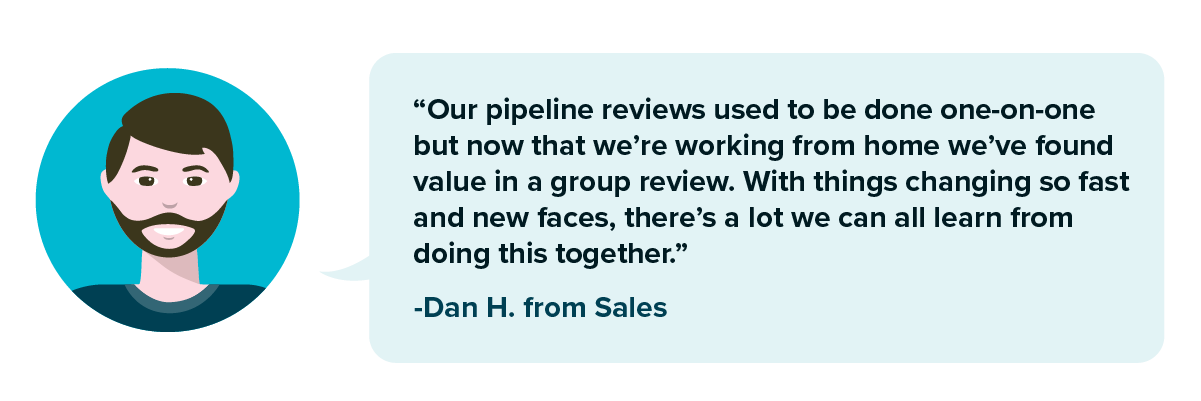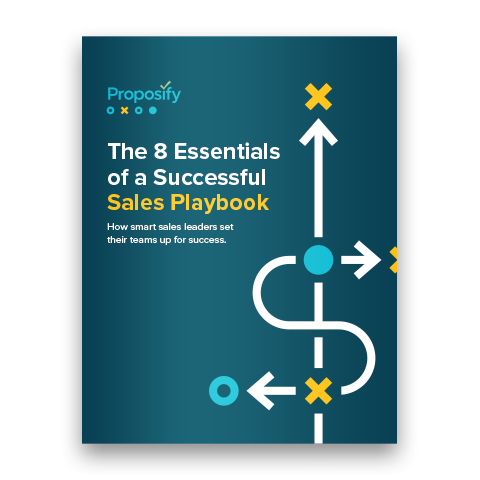Remote Onboarding: The 3 Words Driving Our Process for New Sales Hires
May 12, 2020Last updated on October 1, 2024

Like many organizations and events, Proposify is a fully remote company for the time being. But we’re also a growing company, which means that our new hire training and onboarding is now virtual too. In this post, our HR Advisor Emily weighs in on translating in-person into online and our Director of Sales Daniel talks about how he’s onboarding within a rapidly changing sales landscape, the analog tool he misses most, and what’s been working so well remotely that we’re keeping it even once we’re all back in the office together.
Onboarding is not an event. It’s a process.
That’s a quote from Daniel Hebert, Director of Sales here at Proposify. And it’s never been more true than right now, with our growing team working fully remote. With office life firmly in the rearview — and increasingly, international hiring becoming more commonplace — what does the future of onboarding look like?
I talked to Dan and our human resources advisor Emily Clarke about how they’re managing the realities of remote onboarding for new sales team members. Three things came up again and again that can be summed up in three words: communication, documentation, and action.
Thanks to our amazing Human Resources and Operations team, we already had a solid onboarding process in place. I probably don’t need to tell you that with everyone working from home (or attempting to work with cats on the keyboard and kids on our laps) every process becomes much more challenging.
Since more than one-third of all companies don’t have a formal onboarding process we thought we’d share how we’re working with our standard process, adapting it and finding ways to make it work better in this virtual-only world.
Here’s what Dan and Emily are doing to instill company culture and values virtually, what went a bit awry and how we recalibrated, and what went so right that we’re keeping it as part of the process even when we’re all back in the office.
Communication: How to get new sales team members dialled into the team and company culture via Slack and Zoom from Day 0
I’ll let you in on a little new-hire success secret: average companies start the onboarding process on Day 1. But best-in-class companies are 35% more likely to begin onboarding processes before day one.
Pre-pandemic, Emily would check in with our new hires before their big first day to let them know what to expect, what they needed to bring with them (Coffee? Lunch? A void cheque?) and offer practical advice, like how to locate the somewhat-hidden front door to our office building.
These days, the directions are routes to our new employees’ homes, as Emily and other members of the Operations team have been dropping off their equipment ahead of time so everyone can get set up and comfortable.

She’s found this approach has helped make their first days easier, as some of the tedious preparatory tasks are already done. By the first day, new hires have already installed our communications tools, like Slack, Zoom, and SnapComms, and familiarized themselves with them.
Emily points out that it helps newbies feel connected right away, as they can use Slack to say hi to new team members or sign up for our Frappuccino program, which pairs two Proposify team members up for a getting-to-know-you-better session over a (currently virtual) coffee. With Zoom, they get to meet all our Proposify department heads via video chat and learn more about what other teams do. They can also join in on the daily virtual lunchroom or Friday afternoon happy hour. And receiving SnapComms’ company-wide messages ensures that they stay up-to-date on Proposi-news but also helps them see our brand voice and tone in action.
Over on the sales side, in-team communication is the focus. Daniel says that he and his team found value in including the entire team in conversations that used to be more siloed.

Speaking of togetherness, Daniel says his team is trying to recreate a bit of the open-concept office experience we have at Proposify HQ while everyone works from home offices. “We can’t overhear calls and do quick micro-coaching sessions after someone gets off the call to go over what we just heard.”
Without these ad-hoc training sessions, other team meetings have become even more important. Meetings like “film” reviews, where the whole sales team comes together to critique calls, the daily look-ahead stand-ups, and a weekly keep-the-shop-talk-to-a-minimum social Zoom meet-up are keeping the lines of communication open.
Action: How to ramp up learning and get new salespeople putting knowledge into practice
If the move to remote work has surfaced anything in our onboarding process, it’s that action isn’t always about moving at lightning speed. Sometimes it’s about figuring out proper pacing or reinforcing what’s been taught.
“Onboarding is not just passive learning. Watching, reading, and listening is great but we want sales reps to put what they’re learning into practice as soon as possible,” says Dan. That could be something as simple as a video where the new hire explains what they’ve just learned or by actually jumping on calls with prospects.
“We want it to be a combination of learning and doing with their own opportunities. It’s a fast ramp-up. In 10 days new reps are working with four or five of their own prospects.”
Having set milestones for new hires, like taking on their own opportunities, provides accountability for them and a measuring stick for their manager to use to gauge progress. It keeps the process moving forward but can also show where more time is needed.
Remote onboarding has revealed how the pacing of the program has a huge effect on its success. While new AEs benefit from getting right down to business, Daniel discovered that a more flexible onboarding schedule works better for other roles. “We also added a new sales enablement person and we’ve found we had to slow down that process. It’s just so different.”
The difference is knowing what the role’s goals and milestones look like. The objectives for a sales enablement role are more long-term (like preparing sales training courses) than short-term goals (like an AE getting that first deal under their belt) so the ramp-up can be slower-paced. The focus for the enablement role, he says, is more on communicating knowledge than taking immediate action.
Back in HR, Emily also finds that the slower pace of a virtual onboarding works best for sharing all the details that new employees need to know. “It’s easier to make sure we’re avoiding information overload,” she says, adding that going remote has increased the need and her team’s ability to communicate better because they have to really think through each message. She’s also nixed her usual slide presentation so she can stay face-to-face on calls and sends any documents separately.
Guess less. Win more.
A predictable sales system is your team’s MVP. Increase your win rate with our free framework for creating a successful sales playbook.
Get started
Documentation: How to translate in-person into virtual and make it scalable
When it comes to going virtual, there’s one very analog documentation tool that Daniel misses most: his whiteboard.
“In the office I’m used to doing whiteboard sessions where I can draw out the entire process and show exactly what I’m talking about with circles and arrows,” he says. “Without an iPad or a stylus, I’ve tried to make do with online drawing tools to make shapes and try to replicate that as much as I can while on a Zoom call with my team.”
The new digital onboarding process has forced Daniel to be more diligent about making sure that everything is documented but still streamlined. After noticing that new hires asked many of the same questions, he implemented a team wiki to create a warehouse for all the knowledge the team members have and new folks seek. New AEs access the wiki to find answers to their questions, plus add any questions they’ve asked along with the answers they’ve received from their peers or figured out on their own.
Daniel has also refined the structure of the AE onboarding program in LevelJump, an app administered through Salesforce that guides new sellers and helps them optimize their performance. A well-documented program isn’t just good for short-term success, as mentioned above, but also the long-term company turnover rate: new employees who go through a structured onboarding program are much more likely to stay for three or more years.
Working together while we're apart
Even with a solid tech stack in place, both Daniel and Emily stress the importance of a one traditional tactic that will always be part of our onboarding process: some good old-fashioned check-ins.
Says Emily, "I reach out to new folks every day for the first week to follow up and see if they have any questions. Or if I have questions! Keeping that feedback and communication loop open is so important, especially now that we're all working from home."



